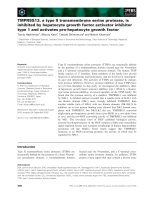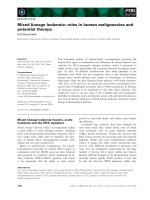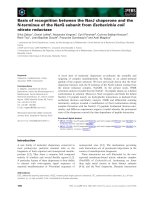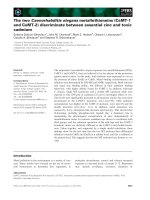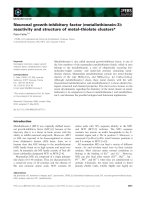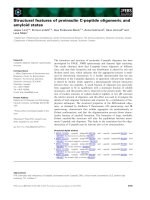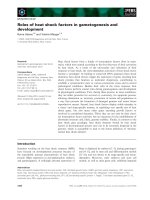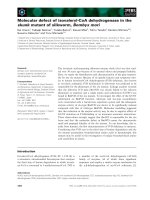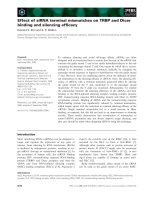Tài liệu Báo cáo khoa học: Agrobacterium tumefaciens type II NADH dehydrogenase Characterization and interactions with bacterial and thylakoid membranes ppt
Bạn đang xem bản rút gọn của tài liệu. Xem và tải ngay bản đầy đủ của tài liệu tại đây (816.97 KB, 13 trang )
Agrobacterium tumefaciens type II NADH dehydrogenase
Characterization and interactions with bacterial and thylakoid
membranes
Laetitia Bernard*
,‡
, Carine Desplats
‡
, Florence Mus
†
, Ste
´
phan Cuine
´
, Laurent Cournac and
Gilles Peltier
CEA Cadarache, Direction des Sciences du Vivant, De
´
partement d’Ecophysiologie Ve
´
ge
´
tale et Microbiologie des Bacte
´
ries et Microalgues,
UMR 6191 CNRS-CEA, Aix-Marseille II, Saint-Paul-lez-Durance, France
Electrons that enter the respiratory chain can originate
from three different types of NADH dehydrogenase.
Complex I (NDH-1), a multisubunit transmembrane
enzyme coupling quinone reduction to proton translo-
cation, is present in bacteria, as well as in plant, fungal
and mammal mitochondria [1]. Multisubunit sodium-
pumping NADH : quinone oxidoreductases are found
in some bacterial respiratory chains [2,3]. Mono-
meric type II NADH dehydrogenases (NDH-2), which
contain a flavinic cofactor and are incapable of H
+
Keywords
flavoenzyme; type II NADH dehydrogenase;
plastoquinone reduction; quinone reduction;
respiration
Correspondence
G. Peltier, CEA Cadarache, Direction des
Sciences du Vivant, De
´
partement
d’Ecophysiologie Vegetale et Microalgues,
UMR 6191 CNRS-CEA, Aix-Marseille II,
F-13108 Saint-Paul-lez-Durance, France
Fax: +33 442 25 62 65
Tel: +33 442 25 76 51
E-mail:
Present address
*UMR Microbiologie et Ge
´
ochimie des sols,
INRA ⁄ Universite
´
de Bourgogne, Dijon,
France
†Department of Plant Biology, The Carnegie
Institution of Washington, Stanford, CA, USA
Note
‡These authors contributed equally to this
study
(Received 4 April 2006, revised 16 May
2006, accepted 9 June 2006)
doi:10.1111/j.1742-4658.2006.05370.x
Type II NADH dehydrogenases (NDH-2) are monomeric enzymes that cat-
alyse quinone reduction and allow electrons to enter the respiratory chain
in different organisms including higher plant mitochondria, bacteria and
yeasts. In this study, an Agrobacterium tumefaciens gene encoding a puta-
tive alternative NADH dehydrogenase (AtuNDH-2) was isolated and
expressed in Escherichia coli as a (His)
6
-tagged protein. The purified
46 kDa protein contains FAD as a prosthetic group and oxidizes both
NADH and NADPH with similar V
max
values, but with a much higher
affinity for NADH than for NADPH. AtuNDH-2 complements the growth
(on a minimal medium) of an E. coli mutant strain deficient in both
NDH-1 and NDH-2, and is shown to supply electrons to the respiratory
chain when incubated with bacterial membranes prepared from this
mutant. By measuring photosystem II chlorophyll fluorescence on thylak-
oid membranes prepared from the green alga Chlamydomonas reinhardtii,
we show that AtuNDH-2 is able to stimulate NADH-dependent reduction
of the plastoquinone pool. We discuss the possibility of using heterologous
expression of NDH-2 enzymes to improve nonphotochemical reduction of
plastoquinones and H
2
production in C. reinhardtii.
Abbreviations
DPI, diphenyleneiodonium; IPTG, isopropyl thio-b-
D-galactoside; NDH-1, NADH dehydrogenase or Complex I; NDH-2, type II NADH
dehydrogenases; PQ, plastoquinone; PS I, photosystem I; PS II, photosystem II; ROS, reactive oxygen species; SOD, superoxide dismutase;
UQ, ubiquinone.
FEBS Journal 273 (2006) 3625–3637 ª 2006 The Authors Journal compilation ª 2006 FEBS 3625
pumping activity, have been evidenced in plant mito-
chondria [4–6], some bacteria [7–9], yeasts [10–12] and
more recently in archae [13] and protozoans [14].
Progress in systematic genome sequencing over the
last decade has revealed numerous putative NDH-2
sequences in various types of organisms [15].
Prokaryotic NDH-2s appear to play an important
role in both aerobic and anaerobic metabolism, and ful-
fil a high diversity of functions, depending on the organ-
ism and the environmental conditions. For example,
in the aerobic nitrogen-fixing bacteria Azotobacter
vinelandii, a NDH-2 protects nitrogenase from O
2
inhi-
bition, by drastically increasing the respiration rate [16].
In the facultative aerobe Bacillus subtilis [17] or in the
obligatory fermentative aerotolerant Zymomonas mobi-
lis [18], NDH-2 has been reported to replace NDH-1 in
a simplified respiratory chain. A NDH-2 has been
shown to mediate electron transfer to the membrane-
bound methane monooxygenase of the methanotroph
Methylococcus capsulatus [19]. In cyanobacteria, the
existence of several NDH-2s has been reported.
Although one of these was able to complement an
Escherichia coli-mutant deficient in NDH-1 and
NDH-2, they were proposed, because of their low activ-
ity, to have a sensor rather than a bioenergetic function
[20]. In other bacteria, although the physiological role of
NDH-2 is still unclear, the NDH-1 ⁄ NDH-2 ratio seems
to be regulated as a function of variations in the growth
conditions [21].
In chloroplasts of higher plants and algae, in addi-
tion to the photosynthetic electron transfer chain oxid-
izing water at photosystem II (PS II) and reducing
NADP
+
at photosystem I (PS I), the existence of a
respiratory chain including both nonphotochemical
reduction and oxidation of the plastoquinone (PQ)
pool has been shown [22]. In higher plant chloroplasts,
dark PQ reduction is mediated by a multisubunit com-
plex homologous to bacterial complex I [23,24]. In the
green unicellular alga Chlamydomonas reinhardtii such
a complex is absent from chloroplasts [22]. Based on
pharmacological studies, the involvement of a plasti-
dial NDH-2 enzyme has been proposed [25,26].
Whether bacterial or mitochondrial NDH-2s, which
normally reduce ubiquinones (UQs), are able to reduce
PQs and interact with the photosynthetic electron
transport chain is not established.
In this study, we report on the isolation of an Agro-
bacterium tumefaciens gene coding for a putative
NDH-2 (AtuNDH-2). Following expression in E. coli,
a His-tagged protein was purified by nickel-affinity
chromatography. The purified AtuNDH-2 recombin-
ant protein is shown to complement growth on a min-
imal medium of an E. coli mutant strain deficient in
both NDH-1 and NDH-2, and to supply electrons to
the respiratory chain when incubated with bacterial
membranes prepared from this mutant. AtuNDH-2
is also shown to reduce PQs of the photosynthetic
electron transport chain when incubated with C. rein-
hardtii thylakoids.
Results
Sequence analysis of AtuNDH-2
The A. tumefaciens genome, which is 60% GC rich, con-
tains a unique protein sequence sharing common fea-
tures with already described NDH-2 genes (NCBI
accession number AI2824). The putative A. tumefaciens
NDH-2 protein sequence (AtuNDH-2) showed
relatively poor identity with E. coli (NDH), Saccharo-
myces cerevisiae (NDE1) and Solanum tuberosum
(StNDB1) protein sequences, respectively, 28, 26 and
25%. The AtuNDH-2 sequence was compared with 49
NDH-2 or putative NDH-2 sequences from prokaryo-
tes, fungi and plants using phylogenetic analysis
(Fig. 1). NDH-2 can be classified in four different
groups, three of which contain prokaryotic NDH-2s.
The ‘prokaryote A’ subgroup includes most of the
known eubacterial NDH-2s, including the E. coli [27],
B. subtilis [17] and A. vinelandii [16] enzymes. The ‘pro-
karyote C’ subgroup contains cyanobacterial NDH-2 as
well as plant NDC [6]. AtuNDH-2 belongs to the poorly
described ‘prokaryote B’ group containing eubacterial
and cyanobacterial sequences. The last subgroup con-
tains plant NDA, NDB as well as yeast and C. rein-
hardtii sequences. AtuNDH-2 shares from 24 to 28%
identity and 40 to 48% similarity with rotenone-insensit-
ive NAD(P)H dehydrogenases of plant mitochondria.
Alignment of representative NDH-2 protein sequences
from the four different families (Fig. 2) revealed high
conservation in two domains showing most of the cri-
teria for dinucleotide binding, including a bab fold and
a GxGxxG motif [28]. Based on a comparison with the
lipoamide dehydrogenase sequence (an enzyme which
shares significant similarity with NDH-2s and the struc-
ture of which has been resolved), the first binding site
can be attributed to FAD and the second to NAD(P)H
[27]. The C-terminal domain of the protein, which con-
tains 20 hydrophobic residues (Fig. 2), has been sug-
gested to anchor the enzyme to the membrane [29].
Expression, purification and biochemical
characterization of AtuNDH-2
In order to express a His-tagged AtuNDH-2 protein
in E. coli, the AtuNDH-2 gene sequence was amplified
Agrobacterium tumefaciens NDH-2 L. Bernard et al.
3626 FEBS Journal 273 (2006) 3625–3637 ª 2006 The Authors Journal compilation ª 2006 FEBS
from genomic DNA, cloned into pSD80 with a C-ter-
minus (His)
6
-tag sequence. The resulting plasmid was
used to transform E. coli strain DH10b. The recom-
binant protein, mainly present in membrane fractions
(Fig. 3A), was purified by nickel-affinity chromatogra-
phy from membrane protein extracts. Following elu-
tion with an imidazole gradient, collected fractions
were loaded on a SDS ⁄ PAGE gel (Fig. 3A). A single
Fig. 1. Phylogenetic analysis of bacterial, plant, fungal and protist NDH-2-like protein sequences. Because lipoamide dehydrogenase shares a
probable common ancestry with NDH-2 (30), the E. coli sequence (LpdA) was chosen as a common root. Corresponding GenBank (GenPept)
accession numbers, NCBI RefSeq numbers or references of the protein sequences used are: E. coli-LpdA, NP_308147; Acidianus ambiva-
lens, CAD33806; C. reinhardtii (N2Cr347); Arabidopsis thaliana (AtNDC), NP_568205; Synechocystis (slr1743), NP_441103; Nostoc-5,
BAB75793; Synechocystis (sll1484), NP_442910; Nostoc-6, BAB76910; Leptospira interrogans, NP_714580; Chlorobium tepidum,
NP_661273; Xanthomonas axonopodis, AAM38664.1; Brucella melitensis , AAL54028; A. tumefaciens (AtuNDH-2), AI2824;
Sinorhizobium meliloti, NP_386185; Mesorhizobium loti, NP_102176; Bradyrhizobium japonicum-1, NP_767691.1; Synechocystis (slr0851),
NP_441107; Nostoc-1, BAB73083; Corynebacterium glutamicum, CAB41413; Mycobacterium smegmatis, AAC46302.1; Nostoc-4,
BAB74663; Desulfovibrio desulfuricans, ZP_00130145; Cytophaga hutchinsonii, ZP_00309856; Bacteroides thetiaotaomicron, NP_810450;
Neurospora crassa (NcNDI1), EAA27430; Trypanosoma brucei, AAM95239; S. tuberosum (StNDA1), CAB52796; A. thaliana (AtNDA1),
NP_563783; N. crassa (NcNDE1), CAB41986; S. tuberosum (StNDB1), CAB52797; A. thaliana (AtNDB1), NP_567801; C. reinhardtii
(N2Cr147), C. reinhardtii (N2Cr247), S. cerevisiae (NDI1), NP_013586; S. cerevisiae (NDE1), NP_013865; S. cerevisiae (NDE2), NP_010198;
Yarrowia lipolytica (YlNDH-2), XP_505856; N. crassa3, EAA29772; Burkholderia cepacia-2, ZP_00224966; Z. mobilis, AAD56918; E. coli,
NP_415627; Haemophilus influenzae, NP_438906; B. cepacia-1, ZP_00223855; A. vinelandi, AAK19737; Pseudomonas fluorescens,
AAF97237; B. japonicum-2, NP_770367.1; Rhodopseudomonas palustris, ZP00010689; Halobacterium, NP_279851; B. subtilis, NP_389111;
Deinococcus radiodurans, NP_294674. When homologue sequences originating from the same organism were closely related, a single repre-
sentative has been selected (e.g. A. thaliana NDAs or NDBs).
L. Bernard et al. Agrobacterium tumefaciens NDH-2
FEBS Journal 273 (2006) 3625–3637 ª 2006 The Authors Journal compilation ª 2006 FEBS 3627
protein band was eluted by 200 mm imidazole. This
band, located below the 50 kDa molecular mass
marker (AtuNDH-2 has an expected size of 46 kDa),
was recognized by an antibody directed against the
poly(His) tag sequence and was recovered mainly in
the membrane fraction. The purified enzyme was used
for further biochemical characterizations. Following
heat denaturation of the enzyme, the flavine cofactor
was analysed by HPLC and identified as FAD
(Fig. 3B). Figure 3C shows the absorption spectrum
of AtuNDH-2 protein. Typical peaks of FAD-con-
taining proteins were observed, confirming the nature
of the cofactor [19]. By using the extinction coeffi-
cient at 450 nm we calculated that the stoichiometric
ratio of flavinic cofactor per mole of protein reaches
1.02 mol, which is characteristic of NDH-2 proteins
[21]. The capacity of the purified enzyme to oxidize
NADH or NADPH was measured by monitoring
absorbance decay at 340 nm in the presence of var-
ious electron acceptors (Table 1). In the presence of
ferricyanide, the NADH-oxidizing activity saturated
around 50 lm NADH and reached 100 nmolÆmin
)1
Ælg
)1
protein. In the presence of NADPH, a significant
activity was measured, but it was not possible to
observe saturation within a concentration range suit-
able for spectrophotometric studies. An activity
of 50 nmolÆ min
)1
Ælg
)1
protein was measured at
200 lm NADPH. Various quinone acceptors were tes-
ted. In the presence of the soluble quinone Q
0
,a
NADH oxidation activity of 140 nmolÆmin
)1
Ælg
)1
pro-
tein was measured. We also tested the ability of the
protein to use decyl-ubiquinone (UQ) and decyl-PQ
as acceptors. Because these quinones are poorly sol-
uble in aqueous solutions, the rates measured in these
experiments should be considered as indicative. Never-
theless, it clearly appears that AtuNDH-2 is able to
catalyse the oxidation of NADH in the presence of
both quinone acceptors (Table 1).
In the absence of acceptors, the enzyme was found
to oxidize NADH and NADPH at limited rates, prob-
ably due to the capacity of the enzyme to interact
directly with O
2
[30]. This property was studied by
measuring O
2
consumption using an O
2
electrode
(Table 2). In this assay, the affinity of the enzyme for
Fig. 2. Conserved sequence motifs in NDH-2s from various organisms. GenBank accession numbers: C. glutamicum, CAB41413; S. tubero-
sum (StNDB1), CAB52797; S. cerevisiae (NDE1), NP_013865; Synechocystis (slr1743), NP_441103. In the consensus sequence, conserved
residues in at least five of seven or six sequences are indicated in one letter code: upper case when conserved in every sequence, lower
case in other cases. Functionally similar residues are marked with the following symbols: D, hydrophobic; fi , aromatic; #, acidic or neutral
counterpart. Grey shaded regions in C-terminal sequences represent hydrophobic fragments detected using
MITOPROT II software (v. 1.0)
corresponding to the maximal local hydrophobicity indicated.
Agrobacterium tumefaciens NDH-2 L. Bernard et al.
3628 FEBS Journal 273 (2006) 3625–3637 ª 2006 The Authors Journal compilation ª 2006 FEBS
NADPH was about four times lower than for NADH.
Similar V
max
values were measured for NADPH and
NADH, but under these conditions, measured V
max
values were
~
50 times lower than in the presence of
ferricyanide or quinone acceptors.
In vitro interaction of AtuNDH-2 with bacterial
and thylakoid membranes
The ability of AtuNDH-2 to interact with bacterial
membranes was studied using membrane preparations
of an E. coli mutant lacking both NDH-1 and NDH-2.
The functionality of the respiratory chain of these
preparations was first checked in the presence of succi-
nate as substrate of complex II (data not shown). As
expected, no O
2
uptake was detected when mutant
membranes were supplemented with NADH (Fig. 4A).
Preincubation of mutant membranes with AtuNDH-2
resulted in an O
2
uptake upon NADH addition,
whereas the enzyme alone consumed O
2
, but at a much
lower rate (Fig. 4B). At variance with respiratory O
2
uptake, which leads to reduction of O
2
into H
2
O,
direct NADH oxidation activity of NDH-2 generates
reactive oxygen species (ROS) [9]. Superoxide dismu-
tase (SOD) and catalase were added to the assay med-
ium to convert back ROS into O
2
and therefore
minimize the contribution of direct oxidation which is
not connected to electron transfer into the respiratory
chain to O
2
uptake. Then, when assays on E. coli
membranes are performed in the presence of these
scavengers, O
2
uptake rates essentially reflect the qui-
none reductase activity of the enzyme (Fig. 4A,B).
Under these conditions, at pH 7.2, similar V
max
values
(
~
3.7 nmol O
2
Æmin
)1
Ælg
)1
protein) were obtained for
both NADH and NADPH oxidations (data not
shown). Diphenyleneiodonium (DPI), an inhibitor of
flavin enzymes, inhibited both NADH- and NADPH-
dependent reactions by
~
75%, half inhibition being
obtained at DPI concentrations of
~
13 lm (data not
shown).
A
B
C
Fig. 3. Purification of His-tagged AtuNDH-2 by nickel-affinity chro-
matography (A) and analysis of the flavinic cofactor (B). (A) Coo-
massie Brilliant Blue-stained SDS ⁄ PAGE and western blot analysis
using an anti-histidine IgG. T, total protein extract from bacterial
cells expressing AtuNDH-2; S, soluble proteins; M, membrane pro-
teins solubilized by dodecyl maltoside; E1 and E2, eluted fractions
from nickel-affinity chromatography using 200 m
M imidazole. MW,
molecular mass markers. (B) HPLC separation and fluorometric ana-
lysis of the flavinic cofactor. Continuous line, cofactor extracted
from purified recombinant AtuNDH-2; dashed black line, FAD stand-
ard; dashed grey line, FMN standard. (C) UV-visible spectrum of
0.3 l
M of purified AtuNDH-2.
Table 1. Kinetic parameters of NADH oxidation determined on puri-
fied AtuNDH-2 in the presence of various electron acceptors, using
spectrophotometric measurements at 340 nm.
K
m
(lM) V
max
(nmolÆmin
)1
Ælg
)1
protein)
Ferricyanide (1 m
M)5 100
Q0 (100 l
M) 3.5 140
PQ (2 m
M)–66
UQ (2 m
M)–26
Table 2. K
m
and V
max
of O
2
reduction by AtuNDH-2 measured
using an O
2
electrode in the presence of NADH and NADPH as
electron donors.
K
m
(lM) V
max
(nmolÆmin
)1
Ælg
)1
protein)
NADH 52.9 2.26
NADPH 201 2.70
L. Bernard et al. Agrobacterium tumefaciens NDH-2
FEBS Journal 273 (2006) 3625–3637 ª 2006 The Authors Journal compilation ª 2006 FEBS 3629
The ability of AtuNDH-2 to interact with PQs of
the photosynthetic electron transport chain was stud-
ied by performing chlorophyll fluorescence measure-
ments on thylakoid membranes of C. reinhardtii
(Fig. 5). When measured under nonactinic light, the
chlorophyll fluorescence level is an indicator of the
PQ pool redox state in the dark [31]. Under anaerobic
conditions to prevent dark reoxidation of the PQ
pool, addition of NADH (200 lm)toC. reinhardtii
thylakoid membranes provoked a slow increase in the
chlorophyll fluorescence level, indicating a reduction
of the PQ pool (Fig. 5). This activity was recently sug-
gested to result from the activity of an endogenous
NDH-2-type enzyme [26]. When AtuNDH-2 was incu-
bated with thylakoid membranes prior to chlorophyll
fluorescence measurements, the redox state of PQ
increased significantly more rapidly, the effect being
dependent on AtuNDH-2 concentrations (Fig. 5).
AtuNDH-2 was also found to stimulate (two- to
threefold) light-dependent O
2
uptake measured in
C. reinhardtii thylakoid membranes in the presence
of NADH, 3-(3,4-dichlorophenyl)-1,1-dimethyl urea
(DCMU) and methyl viologen (data not shown), this
measurement supplying an estimation of the electron
flow from NADH to PS I through the PQ pool [26].
We conclude from these experiments that AtuNDH-2
is able to interact with thylakoid membranes and
reduce PQs.
Functional complementation of a E. coli mutant
strain
Finally, we tested the ability of AtuNDH-2 to function
as a NADH dehydrogenase in vivo by studying its abil-
ity to restore growth of an E. coli mutant strain
ANN0222 lacking both NDH-1 and NDH-2. Such a
deleted strain has been reported to grow normally on a
Luria–Bertani medium, but not be able to grow on a
minimal medium supplemented with mannitol as the
sole source of carbon [20]. As shown in Fig. 6A, con-
trol transformants (corresponding to cells transformed
with empty vector) could not grow on the minimal
medium, nor could untransformed cells (data not
shown). In contrast, the mutant strain expressing
AtuNDH-2 after induction with 0.1 mm isopropyl thio-
b-d-galactoside (IPTG) could grow under these condi-
tions. Note that partial complementation of the mutant
was observed in the absence of IPTG, likely indicating
significant IPTG-independent expression of the protein.
Using an antibody raised against the recombinant pro-
tein, AtuNDH-2 was detected in protein extracts
from the complemented ANN0222 strain (Fig. 6C).
Most of the protein was present in membrane fractions,
A
B
C
Fig. 5. Interaction of AtuNDH-2 with C. reinhardtii thylakoid mem-
branes. The increase in chlorophyll fluorescence was measured
under low light in response to NADH addition (final concentration
200 l
M) to a suspension of C. reinhardtii thylakoids (30 lg chloro-
phyllÆmL
)1
). (A) control; (B, C) thylakoid membranes were preincu-
bated with purified AtuNDH-2 at two protein concentrations (2.5
and 5 lgÆmL
)1
final protein concentration, respectively) for 30 min
before measurements.
A
B
Fig. 4. Interaction of AtuNDH-2 with membranes of the E. coli
mutant ANN0222 and effect of DPI. (A) Effect of AtuNDH-2 on
NADH-dependent O
2
uptake measured in bacterial membranes fol-
lowing addition of 200 l
M NADH; (a) control; (b) purified AtuNDH-2
(1.5 lgÆmL
)1
) was preincubated with bacterial membranes prior to
measurements; (c) effect of SOD (500 unitsÆmL
)1
) and catalase
(1000 unitsÆmL
)1
) addition to (b); (B) NADH-dependent O
2
reduction
by AtuNDH-2 (a) and effect of SOD and catalase addition (b).
Agrobacterium tumefaciens NDH-2 L. Bernard et al.
3630 FEBS Journal 273 (2006) 3625–3637 ª 2006 The Authors Journal compilation ª 2006 FEBS
only a small portion being found in soluble proteins.
Significant expression of AtuNDH-2 was detected in
the absence of IPTG, consistent with the partial com-
plementation observed under these conditions.
AtuNDH-2 activity was assessed on membrane frac-
tions prepared from the transformed mutant strain by
measuring NADH- and NADPH-dependent O
2
con-
sumption rates. Whereas only low O
2
uptake activity
was induced by NADH addition on membranes of the
control transformant strain, strong O
2
uptake was
observed in membranes containing AtuNDH-2
(Fig. 6B). Oxygen-uptake activities were measured in
membranes of the complemented ANN0222 strain to
determine apparent kinetic parameters of AtuNDH-2.
Under these conditions, AtuNDH-2 oxidized both
NADH and NADPH with similar maximal rates, and
with a much higher affinity for NADH (K
m
¼ 12.5 lm)
than for NADPH (K
m
¼ 1129 lm) (data not shown).
Discussion
We report here the cloning, expression and characteri-
zation of AtuNDH-2, the A. tumefaciens orthologue to
rotenone-insensitive NAD(P)H dehydrogenases. The
purified enzyme showed a NADH : Q
0
oxidoreductase
activity in the range of activities measured for other
purified enzymes, such as the C. glutamicum NDH-2
[9] or the Trypanosoma brucei NDH-2 [14]. AtuNDH-2
appears, however, 1000 less active than the purified
His-tagged E. coli enzyme, the high activity of which
has been attributed either to differences in purification
protocols or to the preincubation with phospholipids
[27]. Like several other organisms, including E. coli,
Synechocystis PCC6803 and plant mitochondria, A. tu-
mefaciens appears to contain both a NDH-1 complex
and a functional NDH-2. Whether AtuNDH-2 fulfils a
bioenergetic function or acts as a sensor, as suggested
AB
C
Fig. 6. Growth complementation by AtuNDH-2 of a E. coli mutant lacking both NDH-1 and NDH-2. (A) Colony forming assays on rich med-
ium (Luria–Bertani) and minimal medium (M9) supplemented with mannitol. Control, transformation control of the E. coli strain ANN0222;
AtuNDH-2, ANN0222 transformant strain expressing AtuNDH-2 under the control of an inducible promotor. Induction was realized by addi-
tion of 0.1 m
M IPTG. (B) O
2
uptake measurements in membranes of the E. coli strain ANN0222 (control) and in the transformant strain
expressing AtuNDH-2. NADH (200 m
M final concentration) was added when indicated. (C) Western blot analysis using an antibody raised
against AtuNDH-2. S, soluble protein fraction; M, membrane protein fraction. AtuNDH-2 accumulation was analysed in response to induction
by 0.1 or 0.5 m
M IPTG. Gel loading was 2.5 and 30 lg proteins in M and S lanes, respectively. Right, immunodetection of purified
AtuNDH-2, at 0.1, 0.2 and 0.3 lg protein ⁄ lane from left to right.
L. Bernard et al. Agrobacterium tumefaciens NDH-2
FEBS Journal 273 (2006) 3625–3637 ª 2006 The Authors Journal compilation ª 2006 FEBS 3631
in cyanobacteria [20], will require further study. From
amperometric and chlorophyll fluorescence measure-
ments performed on E. coli membranes and on C. rein-
hardtii thylakoids, AtuNDH-2 is concluded to interact
with bacterial membranes and UQs and also with thyl-
akoid membranes and PQs. Although NDH-2s are
membrane-bound enzymes, the nature of membrane ⁄
protein interactions has not been elucidated. Mem-
brane binding seems to rely on different mechanisms
depending on the enzyme, some involving transmem-
brane anchorage, whereas others involve electrostatic
interactions. A membrane association via amphipha-
tic helices has been suggested for E. coli and
Acidianus ambivalens NDH-2s [13,29]. 2D structure
analysis, performed on the 50 NDH-2 sequences used
to build the phylogenetic tree, predict the presence of
C-terminal transmembrane helices in the prokaryotic B
subgroup (including AtuNDH-2). AtuNDH-2 also
contains a hydrophobic domain enriched in aromatic
residues located between its two cofactor binding sites.
This domain has been proposed to be involved in the
interaction with hydrophobic quinones of respiratory
chains [11,13]. Respective contributions of both hydro-
phobic domains to membrane and quinone interactions
require further study.
In higher plants, addition of NAD(P)H to thylakoid
membrane preparations has been shown to stimulate
nonphotochemical reduction of the PQ pool [31].
Although higher plant chloroplasts contain a func-
tional NDH-1 complex [23,24], pharmacological stud-
ies concluded that a NDH-2-like enzyme is also
involved in this phenomenon [31]. C. reinhardtii chlo-
roplasts are recognized to lack NDH-1 complex [22].
A recent study conducted in our laboratory concluded
that, in C. reinhardtii, the enzyme involved in the dark
reduction of PQs is a NDH-2-type enzyme [26]. Non-
photochemical reduction of PQs is a reaction of spe-
cial interest because it may lead to the production of
hydrogen. Indeed, under anaerobic conditions, C. rein-
hardtii is able to efficiently produce hydrogen, using
solar energy and water, because of the existence of a
reversible hydrogenase connected to its photosynthetic
electron transport chain [32]. Photobiological hydro-
gen production is a natural phenomenon of high bio-
technological interest [33,34], but is strongly limited by
the extreme O
2
sensitivity of the hydrogenase, O
2
being produced by PS II during photosynthesis. To
overcome this limitation, the development of a sequen-
tial inhibition of PS II based on sulfur deprivation,
has been proposed [35]. Under conditions of sulfur
deficiency, PS II activity is inhibited, allowing the
establishment of anaerobic conditions favourable to
hydrogen production. In the absence of PS II, hydro-
gen production is possible thanks to the existence of a
nonphotochemical PQs reduction pathway using stro-
mal reductants originating from starch catabolism
[36,37]. This pathway, which allows hydrogen produc-
tion without simultaneous O
2
production and can sus-
tain hydrogen production on a relatively long time
scale [37], was recently proposed to involve a plastidial
NDH-2 [26]. Because nonphotochemical reduction of
PQ may constitute a limiting step of hydrogen produc-
tion under certain experimental conditions, overexpres-
sion of a NDH-2 in C. reinhardtii plastid should be
considered as a valuable optimization strategy towards
improving the anaerobic phase of hydrogen produc-
tion. AtuNDH-2 appears as a suitable gene for such a
purpose because its high GC content is similar to that
of C. reinhardtii genomic DNA. The obtention of
transformants expressing AtuNDH-2 is currently in
progress in our laboratory.
AtuNDH-2 showed a much higher affinity for
NADH than for NADPH, although both substrates
were oxidized with comparable V
max
values (Table 2).
Several NDH-2s are strict NADH- [14,27] or strict
NADPH-dehydrogenases [15,38], whereas a few others,
mainly from plants, are able to oxidize both substrates
indifferently [5]. Michalecka et al. [38] suggested that
the presence of an acidic residue (E or D) at the end
of the second b sheet of the dinucleotide-binding site
would confer NADH specificity by providing hydrogen
bonding to the ribose moiety (Fig. 2). In enzymes
specifically oxidizing NADPH, this acidic residue is
replaced by a neutral counterpart (Q or N). The pres-
ence of a glutamic residue in AtuNDH-2 is in agree-
ment with the enzyme preference for NADH.
However, AtuNDH-2 was able to oxidize NADPH at
a similar maximal rate, but with a lower affinity.
Although molecular basis of the NDH-2s ability to use
both substrates are currently unknown, this property
will be important for optimizing hydrogen production
through chloroplast engineering, NADPH being gener-
ally thought to be the major form of reducing power
in this compartment.
Like most reported alternative NADH dehydrogen-
ases [39,40], AtuNDH-2 was shown to contain FAD
as a prosthetic group. FAD-containing enzymes dri-
ving two-electron reduction are believed to be less
likely than FMN-containing enzymes to produce su-
peroxides [41]. Nevertheless, AtuNDH-2, which con-
tains FAD, has the ability to produce ROS at a
significant rate (Table 1). Whereas very few other stud-
ies have considered this autoxidation trait [9], Messner
& Imlay [30] have shown that E. coli NDH-2 is a pri-
mary site of superoxide formation in the aerobic res-
piratory chain, with intensity varying according to its
Agrobacterium tumefaciens NDH-2 L. Bernard et al.
3632 FEBS Journal 273 (2006) 3625–3637 ª 2006 The Authors Journal compilation ª 2006 FEBS
expression level and reduction status. Such a property
may limit the potential biotechnological use of NDH-2-
like enzymes. Expression of AtuNDH-2 in plastids
may therefore lead to the generation of additional
ROS which may alter cell viability and in the case
chloroplast-detoxifying mechanisms would be limiting.
This property should be taken into consideration
in experiments aiming to overexpress NDH-2-like
enzymes in plastids.
Experimental procedures
Strains and media
A. tumefaciens C58 was grown in Luria–Bertani medium
(1% tryptone, 0.5% yeast extract, 0.5% NaCl, pH 7.0) in
the presence of rifampicine (100 lgÆmL
)1
)at30°C for 24 h
before genomic DNA extraction. Cloning and gene expres-
sion were performed in E. coli dH10b. The E. coli mutant
lacking both NDH-1 and NDH-2 ANN0222 was gener-
ously provided by T. Friedrich (Freiburg University,
Germany). Complementation assays were performed on a
minimal medium supplemented with mannitol (1· M9 salts,
2 · 10
)3
m MgSO
4
,10
)4
m CaCl
2
, 0.4% mannitol). Trans-
formed bacteria were selected on Luria–Bertani medium
containing ampicillin (100 lgÆmL
)1
). C. reinhardtii wild-
type (137c) was grown in a Tris-acetate phosphate medium
as described previously [42]. Algal culture was maintained
at 25 °C under continuous agitation and under an illumin-
ation of 100 lmolÆphotonÆm
)2
Æs
)1
.
Chemicals
All chemicals were purchased from Sigma-Aldrich (St
Louis, MO, USA) except DNP-INT which was generously
provided by A. Trebst (Bochum University, Germany).
Cloning, expression and purification of
His-tagged NDH-2
The AtuNDH-2 gene was amplified from A. tumefaciens ge-
nomic DNA, using the following couple of primers: (F)
CGCCAATTGATGCAAGAACATCATGTT; (R) AAAA
CTGCAGTCAATGATGATGATGATGATGGGCCTCG
TCCTTCAGCG. MfeI and PstI sites were inserted in for-
ward and reverse primers, respectively, upstream and down-
stream the start and the stop codons, whereas a (His)
6
-
coding sequence was inserted in the reverse primer right
upstream the stop codon. The amplified DNA was digested
by MfeI and PstI and ligated into the ampicillin-resistant
expression vector pSD80 [43], which was digested by EcoRI
and PstI, and introduced by electroporation in E. coli
dH10b. Ampicillin-resistant transformants were screened by
PCR for the presence of the AtuNDH-2 gene, using (F) and
(R) primers. The construct has been verified by sequencing.
The plasmid was named pSDN2Ag6H and used to cotrans-
form E. coli dH10b with chloramphenicol-resistant pRare
plasmid, carrying genes coding for the six rarest tRNA
of E. coli (Merck Biosciences, Darmstadt, Germany).
His-tagged NDH-2 was expressed in Luria–Bertani medium
in the presence of 50 lgÆmL
)1
ampicillin and 25 lgÆmL
)1
chloramphenicol and incubated at 37 °C under vigorous
shaking. Expression was induced for 2 h by the addition of
0.5 mm IPTG when the culture reached D ¼ 0.5. Cells were
then harvested by centrifugation and washed with a solu-
tion containing 500 mm KCl, 10 mm Tris ⁄ HCl, pH 7.5,
0.2 mm phenylmethylsulfonyl fluoride and stored at
)80 °C.
Protein purification
Membrane isolation and nickel-affinity purification of
A. tumefaciens His-tagged NDH-2 were performed follow-
ing the protocol developed by Bjo
¨
rklo
¨
f et al. [27] for purifi-
cation of an His-tagged E. coli NDH-2. Membranes were
solubilized using dodecyl maltoside and the enzyme was
purified by FPLC (A
˚
kta
˚
FPLC, Amersham Biosciences,
Uppsala, Sweden) using a HiTrap chelating nickel column
(Amersham Biosciences). The bound NDH-2 was eluted
using an imidazole gradient. Collected fractions were ana-
lysed by SDS ⁄ PAGE.
Immunological analysis
A commercial antibody directed against the His-tag
sequence (Sigma ref. H-1029) was used to identify the puri-
fied protein. The purified enzyme was collected in a 5 mL
volume and concentrated by ultrafiltration to a 900 lL final
volume. Glycerol 100% (200 lL) was added before )80 °C
storage. The enzyme concentration was estimated by
SDS ⁄ PAGE comparing to a range of BSA standards. A
rabbit serum was raised against the purified AtuNDH-2
protein (Agro-Bio, Villeny, France) and further used to
probe the presence of the AtuNDH-2 protein in soluble
and membrane protein fractions. Proteins were separated
on a 10% SDS ⁄ PAGE gel and transferred to a nitrocellu-
lose membrane using a semidry transfer technique. The
appropriate antibody was correctly diluted: 1 : 2000 diluted
anti-His IgG (Fig. 3); 1 : 10 000 diluted polyclonal anti-
(AtuNDH-2) serum (Fig. 6). For the anti-His IgG, the
detection reaction (anti-rabbit alkaline phosphatase conju-
gated as secondary antibody) was performed according to
the protocol recommended by the manufacturer (Sigma).
For the anti-(AtuNdh2) IgG, the Alexa 680 goat anti-rabbit
(Invitrogen, Molecular Probes, Carlsbad, CA, USA) was
used as secondary antibody and the detection was per-
formed by using the LICOR (Lincoln, NE, USA) Odyssey
system.
L. Bernard et al. Agrobacterium tumefaciens NDH-2
FEBS Journal 273 (2006) 3625–3637 ª 2006 The Authors Journal compilation ª 2006 FEBS 3633
Colony-forming assays
ANN0222 competent cells were transformed either with
pSDN2ag6 h plasmid or empty vector as a control and
transformants were selected on Luria–Bertani agar contain-
ing ampicillin. Transformants were grown to mid-exponen-
tial phase at 37 °C in ampicillin-containing Luria–Bertani
medium. Cells were washed once with sterile M9 medium
supplemented with mannitol as the sole source of carbon.
Cells were then diluted in M9 ⁄ mannitol medium and spot-
ted on M9 ⁄ mannitol ⁄ agar plates containing ampicillin and
different IPTG concentrations. Plates were incubated at
37 °C for two days. As a control, cells were plated on a
Luria–Bertani agar medium containing ampicillin and
appropriate IPTG concentrations and incubated at 37 °C
overnight.
Flavin analysis
The nature of the flavinic cofactor was determined as des-
cribed previously [14]. The purified enzyme was boiled for
3–4 min followed by centrifugation. Supernatant was ana-
lysed by HPLC using a 150 · 4.6 mm internal diameter.
Supelcosil LC-DP column (Sigma-Aldrich). The composi-
tion of the mobile phase (flow rate of 1 mLÆmin
)1
) was
80% of 0.1% TFA in water and 20% of 0.1% TFA in
40% acetonitrile. Excitation and emission wavelengths of
the fluorescence detector were set at 450 and 525 nm,
respectively. FAD and FMN standards were used to iden-
tify the nature of the flavinic cofactor. UV-visible spectra
of native and boiled proteins were recorded using a Cary-
50 spectrophotometer (Varian, Palo Alto, CA, USA). Pro-
teins were diluted in 50 mm Tris ⁄ HCl buffer pH 7.5,
10 mm NaCl, 5 mm MgCl
2
and the FAD content was
determined spectrophotometrically in protein free superna-
tant from boiled samples (e
450
¼ 11 300 m
)1
Æcm
)1
).
Preparation of bacterial and thylakoid
membranes
A 50 mL Luria–Bertani–tetracyclin E. coli ANN0222 cul-
ture was harvested at the end of exponential growth phase
(D ¼ 1) by centrifugation (15 min, 3200 g). Cells were
washed twice and resuspended in 10 mL of lysis buffer A
(200 mm Tris ⁄ Cl pH 8, 2.5 mm EDTA and 0.2 mm phenyl-
methylsulfonyl fluoride) according to Bjo
¨
rklo
¨
f et al. [27].
Cells were disrupted by passing twice through a chilled
French pressure cell maintained at 16 000 p.s.i., and mem-
brane fraction was collected by centrifugation (30 min,
4 °C, 48 500 g, Beckman JA-20 rotor; Beckman Coulter,
Fullerton, CA, USA). Membranes were resuspended in
200 lL of analysis buffer B (50 mm phosphate buffer,
pH 7.5 and 150 mm NaCl) according to Bjo
¨
rklo
¨
f et al. [27].
The same procedure was followed to prepare membranes
from ANN.0222 transformed cells either with pSD80 or
pSDN2Ag6H.
A 200 mL volume of C. reinhardtii culture grown on Tris-
acetate phosphate medium was harvested in exponential
growth phase, centrifuged, washed in 35 mm Hepes-NaOH
buffer, pH 7.2 and resuspended in 12 mL of buffer C
(50 mm Tricine-NaOH, 10 mm NaCl, 5 mm MgCl
2
;pH8)
supplemented with 1% BSA w ⁄ v, 1 m m benzamidine, 1 mm
phenylmethylsulfonyl fluoride. The following operations
were carried out in the dark at 4 °C. Cells were disrupted by
two cycles of a chilled French pressure cell (2000 p.s.i).
The homogenate was centrifuged at 500 g for 5 min using
an Eppendorf 8510R centrifuge (Eppendorf, Hamburg,
Germany). The pellet, containing unbroken cells, was discar-
ded. The supernatant was centrifuged at 3000 g for 15 min
using an Eppendorf 8510R centrifuge to collect thylakoid
membranes. Thylakoid membranes were resuspended in
250–500 lL of buffer C and stored on ice, in the dark. Chlo-
rophyll extraction was performed in 80% acetone ⁄ H
2
Ov⁄ v,
and chlorophyll concentration was calculated from absorp-
tion measurements at 663 and 646 nm [44].
Spectrophotometric measurement of enzymatic
activity
Assays of NAD(P)H oxidation were performed by monitor-
ing absorbance decrease at 340 nm, concentration variations
being deduced from these measurements by applying the
extinction coefficient of NAD(P)H at this wavelength
(6.22 mm
)1
Æcm
)1
). NAD(P)H, acceptors and protein extracts
(incubated or not with membranes of E. coli ANN0222) were
added successively. Bovine SOD (500 unitsÆmL
)1
) and cat-
alase (1000 unitsÆmL
)1
) were added to the assay medium.
O
2
uptake by bacterial and thylakoid membranes
O
2
uptake was measured using a Clark electrode (DW2 ⁄ 2,
Hansatech, King’s Lynn, UK). In some experiments, a
reaction mixture containing 10 lL of membranes of E. coli
ANN0222 and 1.5 lg of purified enzyme was preincubated
10 min on ice, then diluted in 990 lL of buffer B and intro-
duced into the electrode chamber. O
2
consumption was
measured at 25 °C in the presence of NADH or NADPH.
O
2
uptake was also followed in absence of bacterial mem-
branes to measure direct oxidation by the enzyme. Catalase
(1000 unitsÆmL
)1
) and SOD (500 unitsÆmL
)1
) were added to
the assay medium. Inhibitory effects of DPI were quantified
after 10 min incubation with membrane samples before
measurements.
Chlorophyll fluorescence measurements
Measurements were achieved at 25 °C, in anaerobic condi-
tions a pulse modulated amplitude fluorometer (PAM
Agrobacterium tumefaciens NDH-2 L. Bernard et al.
3634 FEBS Journal 273 (2006) 3625–3637 ª 2006 The Authors Journal compilation ª 2006 FEBS
101-103, Walz, Effeltrich, Germany). The optic fibre of the
fluorometer was placed close to the glass tube of the O
2
electrode reaction chamber (1 mL reaction volume: 50 l L
of thylakoid membrane suspension and 950 lL of buffer C,
pH 7.2). Nonactinic modulated light (650 nm, 1.6 kHz) was
used to determine the chlorophyll fluorescence level F
0
. The
maximal chlorophyll fluorescence level (F
m
) was measured
under 1 s saturating light pulse (~ 1000 lmol photonsÆ
m
)2
Æs
)1
). Anaerobiosis was achieved ~ 15 min before meas-
urements by addition to the thylakoid membrane
suspension of glucose (10 mm) and glucose oxidase
(2 mgÆmL
)1
) in the presence of catalase (8000 unitsÆmL
)1
).
Bioinformatics
Database searches of NDH-2 homologues were performed
at the National Center of Biotechnology Information
web site () using BLASTp and
tBLASTn algorithms [45]. Multiple alignments were
achieved by using the multalin software located on the
Institut National de la Recherche en Agronomie (Toulouse,
France) web site ( />multalin.html). The phylogenetic tree was obtained by
neighbour-joining analysis of 50 whole protein sequences
using clustalw algorithm, with default parametrization,
and with the treeviewppc software. Predictions of trans-
membrane helices were applied using the tmhmm program,
based on a hidden Markov model ( />services/TMHMM/). mitoprot ii (v. 1.0) was used to deter-
mine segments of high local hydrophobicity [46].
Acknowledgements
We are grateful to Professor Thorsten Friedrich for
providing the E. coli double mutant strain ANN0222.
References
1 Friedrich T (2001) Complex I: a chimaera of redox and
conformation-driven proton pump? J Bioenerg Bio-
membr 33, 169–177.
2 Steuber J (2001) Na
+
translocation by bacterial NADH
: quinone oxidoreductases: an extension to the complex-
I family of primary redox pumps. Biochim Biophys Acta
1505, 45–56.
3 Bertsova YV & Bogachev AV (2004) The origin of the
sodium-dependent NADH oxidation by the respiratory
chain of Klebsiella pneumoniae. FEBS Lett 563, 207–212.
4 Menz RI & Day DA (1996) Purification and characteri-
zation of a 43-kDa rotenone-insensitive NADH dehy-
drogenase from plant mitochondria. J Biol Chem 271,
23117–23120.
5 Rasmusson AG, Svensson AS, Knoop V, Grohmann L
& Brennicke A (1999) Homologues of yeast and bacter-
ial rotenone-insensitive NADH dehydrogenases in
higher eukaryotes: two enzymes are present in potato
mitochondria. Plant J 20, 79–87.
6 Michalecka AM, Svensson AS, Johansson FI, Agius
SC, Johanson U, Brennicke A, Binder S & Rasmusson
AG (2003) Arabidopsis genes encoding mitochondrial
type II NAD(P)H dehydrogenases have different evolu-
tionary orgin and show distinct responses to light. Plant
Physiol 133, 642–652.
7 Bragg PD & Hou C (1967) Reduced nicotinamide ade-
nine dinucleotide oxidation in Escherichia coli particles.
2. NADH dehydrogenases. Arch Biochem Biophys 119,
202–208.
8 Jaworoski A, Campbell HD, Poulis MI & Young IG
(1981) Genetic identification and purification of the
respiratory dehydrogenase of Escherichia coli. Biochem-
istry 20, 2041–2047.
9 Matsushita K, Otofuji A, Iwahashi M, Toyama H &
Adachi O (2001) NADH dehydrogenase of Corynebac-
terium glutamicum. Purification of an NADH dehydro-
genase II homolog able to oxidize NADPH. FEMS
Microbiol Lett 204, 271–276.
10 De Vries S & Grivell LA (1988) Purification and charac-
terization of a rotenone-insensitive NADH : Q6 oxido-
reductase from mitochondria of Saccharomyces
cerevisiae. Eur J Biochem 176 , 377–384.
11 Kerscher SJ, Okun JG & Brandt U (1999) A single
external enzyme confers alternative NADH : ubiquinone
oxidoreductase activity in Yarrowia lipolytica. J Cell Sci
112, 2347–2354.
12 Melo AMP, Duarte M & Videira A (1999) Primary
structure and characterisation of a 64 kDa NADH
dehydrogenase from the inner membrane of Neurospora
crassa mitochondria. Biochim Biophys Acta 1412, 282–
287.
13 Bandeiras TM, Salgueiro C, Kletzin A, Gomes CM &
Teixera M (2002) Acidianus ambivalens type-II NADH
dehydrogenase: genetic characterisation and identifica-
tion of the flavin moiety as FMN. FEBS Lett 531 , 273–
277.
14 Fang J & Beattie DS (2002) Novel FMN-containing
rotenone-insensitive NADH dehydrogenase from Trypa-
nosoma brucei mitochondria: isolation and characteriza-
tion. Biochemistry 41, 3065–3072.
15 Melo AM, Bandeiras TM & Teixeira M (2004) New
insights into type II NAD(P)H : quinone oxidoreduc-
tases. Microbiol Mol Biol Rev 68, 603–616.
16 Bertsova YV, Bogachev AV & Skulachev VP (2001)
Noncoupled NADH : ubiquinone oxidoreductase of
Azotobacter vinelandii is required for diazotrophic
growth at high oxygen concentrations. J Bacteriol 183,
6869–6874.
17 Bergsma J, Van Dongen MBM & Konings WN
(1982) Purification and characterization of NADH
L. Bernard et al. Agrobacterium tumefaciens NDH-2
FEBS Journal 273 (2006) 3625–3637 ª 2006 The Authors Journal compilation ª 2006 FEBS 3635
dehydrogenase from Bacillus subtilis. Eur J Biochem
128, 151–157.
18 Kim JY, Song K & Rhee S (1995) A novel aerobic
respiratory chain-linked NADH oxydase system in
Zymomonas mobilis. J Bacteriol 177, 5176–5178.
19 Cook SA & Shiemke AK (2002) Evidence that a type-2
NADH : quinone oxidoreductase mediates electron
transfer to particulate methane monooxygenase in
Methylococcus capsulatus. Arch Biochem Biophys 398,
32–40.
20 Howitt CA, Udall PK & Vermaas WFJ (1999) Type 2
NADH dehydrogenases in the cyanobacterium Synecho-
cystis sp. strain PCC 6803 are involved in regulation
rather than respiration. J Bacteriol 181, 3994–4003.
21 Yagi T (1991) Bacterial NADH–quinone oxidoreductas-
es. J Bioenerg Biomembr 23, 211–225.
22 Peltier G & Cournac L (2002) Chlororespiration. Annu
Rev Plant Biol 53, 523–550.
23 Burrows PA, Sazanov LA, Svab Z, Maliga P & Nixon
PJ (1998) Identification of a functional respiratory com-
plex in chloroplasts through analysis of tobacco mutants
containing disrupted plastid ndh genes. EMBO J 17,
868–876.
24 Rumeau D, Becuwe-Linka N, Beyly A, Louwagie M,
Garin J & Peltier G (2005) New subunits NDH-M-N,
and -O, encoded by nuclear genes, are essential for plas-
tid Ndh complex functioning in higher plants. Plant Cell
17, 219–232.
25 Cournac L, Guedeney G, Joet T, Rumeau D, Latouche
G, Cerovic Z, Redding K, Horvath E, Medgyesy P &
Peltier G (1998) Non-photochemical reduction of inter-
system electron carriers in chloroplasts or higher plants
and algae. In Photosynthesis: Mechanisms and Effects
(Garab G, ed.), pp. 1877–1882. Kluwer Academic,
Dordrecht, The Nertherlands.
26 Mus F, Cournac L, Cardettini V, Caruana A & Peltier
G (2005) Inhibitor studies on non-photochemical plasto-
quinone reduction and H
2
photoproduction in Chlamy-
domonas reinhardtii. Biochim Biophys Acta 1708, 322–
332.
27 Bjo
¨
rklo
¨
f K, Zickermann V & Finel M (2000) Purifica-
tion of the 45 kDa, membrane bound NADH dehydro-
genase of Escherichia coli (NDH-2) and analysis of its
interaction with ubiquinone analogues. FEBS Lett 467,
105–110.
28 Wierenga RK, Terpstra P & Hol WGJ (1986) Prediction
of the occurrence of the ADP-binding bab-fold in pro-
teins, using an amino acid sequence fingerprint. J Mol
Biol 187, 101–107.
29 Rapisarda VA, Chehin RN, De las Rivas J, Rodriguez-
Montelongo L, Farias RN & Massa EM (2002) Evi-
dence for Cu(I)-thiolate ligation and prediction of a
putative copper-binding site in the Escherichia coli
NADH dehydrogenase-2. Arch Biochem Biophys 405,
87–94.
30 Messner KR & Imlay JA (1999) The identificationof
primary sites of superoxide and hydrogen peroxide for-
mation in the aerobic respiratory chain and sulfite
reductase complex of Escherichia coli. J Biol Chem 274,
10119–10128.
31 Corneille S, Cournac L, Guedeney G, Havaux M & Pel-
tier G (1998) Reduction of the plastoquinone pool by
exogenous NADH and NADPH in higher plant chloro-
plasts. Characterization of a NAD(P)H–plastoquinone
oxidoreductase activity. Biochim Biophys Acta 1363,
59–69.
32 Happe T & Naber JD (1993) Isolation, characterization
and N-terminal amino acid sequence of hydrogenase
from the green alga Chlamydomonas reinhardtii. Eur J
Biochem 214, 475–481.
33 Melis A & Happe T (2001) Hydrogen production.
Green algae as a source of energy. Plant Physiol 127,
740–748.
34 Melis A (2002) Green alga hydrogen production: pro-
gress, challenges and prospects. Int J Hydrogen Energy
27, 1217–1228.
35 Melis A, Zhang LP, Forestier M, Ghirardi ML & Sei-
bert M (2000) Sustained photobiological hydrogen gas
production upon reversible inactivation of oxygen evo-
lution in the green alga Chlamydomonas reinhardtii.
Plant Physiol 122, 127–135.
36 Posewitz MC, Smolinski SL, Kanakagiri S, Melis A,
Seibert M & Ghirardi ML (2004) Hydrogen photopro-
duction is attenuated by disruption of an isoamylase
gene in Chlamydomonas reinhardtii. Plant Cell 16, 2151–
2163.
37 Fouchard S, Hemschemeier A, Caruana A, Pruvost J,
Legrand J, Happe T, Peltier G & Cournac L (2005)
Investigations on autotrophic and mixotrophic
hydrogen photoproduction in sulphur-deprived
Chlamydomonas cells. Appl Environ Microbiol 71,
6199–6205.
38 Michalecka AM, Agius SC, Møller IM & Rasmusson
AG (2004) Identification of a mitochondrial
external NADPH dehydrogenase by overexpression
in transgenic Nicotiana sylvestris. Plant J 37,
415–425.
39 Kerscher SJ (2000) Diversity and origin of alternative
NADH : ubiquinone oxidoreductases. Biochim Biophys
Acta 1459, 274–283.
40 Joseph-Horne T, Hollomon DW & Wood PM (2001)
Fungal respiration: a fusion of standard and alterna-
tive components. Biochim Biophys Acta 1504, 179–
195.
41 Luttik MAH, Overkamp KM, Kotter P, de Vries S,
van Dijken JP & Pronk JT (1998) The Saccharomyces
cerevisiae NDE1 and NDE2 genes encode separate
mitochondrial NADH dehydrogenases catalyzing the
oxidation of cytosolic NADH. J Biol Chem 273,
24529–24534.
Agrobacterium tumefaciens NDH-2 L. Bernard et al.
3636 FEBS Journal 273 (2006) 3625–3637 ª 2006 The Authors Journal compilation ª 2006 FEBS
42 Harris EH (1989) The Chlamydomonas Sourcebook. A
Comprehensive Guide to Biology and Laboratory Use.
Academic Press, San Diego, CA.
43 Smith SP, Barber KR, Dunn SD & Shaw GS (1996)
Structural influence of cation binding to recombinant
human brain S100b: Evidence for calcium-induced expo-
sure of a hydrophobic surface. Biochemistry 35, 8805–
8814.
44 Lichtenthaler HK & Wellburn AR (1983) Determina-
tion of total carotenoids and chlorophylls a and b of
leaf extracts in different solvents. Biochem Soc Trans 11,
591–592.
45 Altschul SF, Madden TL, Schaffer AA, Zhang J, Miller
W & Lipman DJ (1997) Gapped BLAST and PSI-
BLAST: a new generation of protein database search
programs. Nucleic Acids Res 25, 3389–3402.
46 Claros MG (1995) MitoProt, a Macintosh application
for studying mitochondrial proteins. Comput Appl Biosci
11, 441–447.
47 Mus F (2005) Activite
´
NAD(P)H plastoquinone oxy-
dore
´
ductase et photo-production d’hydroge
`
ne au sein
des thylacoı
¨
des de l’algue verte Chlamydomonas rein-
hardtii, PhD Thesis, Universite
´
d’Aix-Marseille II,
Aix-Marseille, France.
L. Bernard et al. Agrobacterium tumefaciens NDH-2
FEBS Journal 273 (2006) 3625–3637 ª 2006 The Authors Journal compilation ª 2006 FEBS 3637

